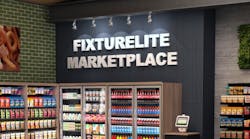After moderating a webinar that was produced by Automatic Merchandiser and Vending Market Watch for snack leader Mondelez International Inc., I began to consider how the topic, “Generational Snacking Trends,” applied to the world of micro market design. With four generations currently operating in the workplace, it is important to consider the different work styles of each generation when designing a micro market and a break room environment.
Baby Boomers doing design
“One of the risks that operators run when we are putting together a micro market design is to create something that is perfect for us, which is a problem if ‘us’ is a Baby Boomer or even a Gen Xer,” said Steve Orlando, cofounder of Fixturelite, the industry’s leading supplier of micro market retail displays, equipment and design tools. “We have to keep in mind that the end users today are predominantly made up of Millennials and Gen Z. They have different workplace priorities than their older counterparts.”
The scorecard
According to Forbes ,agazine, “Baby Boomers usually refers to the post-World War II generation, born between 1946 and 1964. Generation-X represents people born between 1965 and 1980. Generation-Y, most often referred to as Millennials, span the birth years of 1981–1997. Anyone born between 1997 and 2012 is considered a member of Gen-Z.”
At the moment, Gen-Z and Millennials make up about 75% of the workforce. They are the force to be reckoned with and catered to.
A study by Knoll focused on workplace priorities of each generational group and not surprisingly, the results point to some clear differences between the groups.
Baby Boomers: almost entirely out the door
“The two most important features to Boomers are acoustic privacy, followed by quality of meeting spaces. Their least important feature is an engaging workplace. These results reflect the Baby Boomer work style which emphasizes face to face meetings combined with sensitivity to being overheard (which is sometimes used to justify a request for a private office). Issues of security, comfort and casual interaction are significantly less important to Baby Boomers.”
Gen X: often senior management, but numbers are dwindling every day
Like Millennials, “Generation X rates an engaging workplace as its most important issue. Not surprisingly, safety and security at work is Generation X’s second most important workplace issue, since their early lives were impacted by issues related to lack of physical, financial and emotional security. They rate support for casual interaction as a close third in importance. Acoustic privacy is the least important issue for Generation X.”
Millennials: over 50% of the workforce
“Because technology has freed this generation’s members to choose where and when they will work, the degree to which workspace provides an engaging experience is most important to its members. They rate security, comfort, and casual interaction about equivalent in importance. They reserve their lowest ratings for quality of meeting spaces.
Gen-Z: coming on strong and preparing for ultimate majority status
Forbes lays out the Gen-Z mindset: “Despite earning a reputation for being unmotivated or impractical by older generations, many in Gen-Z are willing to work hard for the financial security that they desire. A study found that 58% of Gen-Z workers were willing to work nights and weekends if it meant achieving a higher salary.
But it isn’t just money that Gen-Z workers seem to value; indeed, they also have high expectations for proactive communication, strong connections and transparency in their place of work.”
Human connection
While they may earn the reputation of being glued to their smartphone screens, in fact, Gen-Z workers seem to highly value relationships and in person communication in a workplace. The study found that “90% of Gen-Z workers desire and value a human connection when it comes to their at-work communication.”
Designing for the actual end users
“What micro market operators should take from these studies is the importance of working closely with clients during the design process,” Orlando noted. “The days of lining up the coolers, shelving and a kiosk and calling it a micro market are over. Those who fail to invest in design to create a retail space that addresses the priorities of Millennials and Gen-Z, will be shown the door by office managers from the generational groups they are failing to serve. We see it happening more often than ever before.”
Critical Tools
Tools like the Fixturelite Design Tool and the new Fixturelite Virtual Showroom offer operators two ways to build a breakroom experience, side by side with the client. “These tools have a proven track record. They provide a unique opportunity for an operator to work closely with the client to identify the priorities and the needs of a specific workplace environment,” Orlando said.
Orlando has seen a very positive reaction to soft furniture, the Fixturelite “Off the Wall” collection, Parsons tables and any micro market feature that encourages engagement and a collaborative environment. “Think Millennial and Gen-Z when you are designing a market and you will enjoy a competitive advantage,” he said. “We have the tools to help operators identify exactly what their clients are looking for.”
Check out the video that Fixturelite’s Steve Orlando prepared for the 2021 NAMA Show.: Conquering the New Micro Market Frontier – A Discussion About Design
About the Author
Industry consultant and contributing editor Bob Tullio (www.tullioB2B.com) is a content specialist who advises operators in the convenience services industry on how to build a successful business from the ground up and advises industry suppliers on how to successfully connect with operators. Tullio’s YouTube channel, b2b Perspective, is designed to “elevate your business in two minutes.” Tullio is currently developing an online course, Leverage the power of LinkedIn to grow your business.
A recognized industry expert in business development and sales, NAMA retained him to write and narrate an online course, “Selling Convenience Services,” which is now available. Use discount code B2B10 for an instant discount and for free access to upcoming Q&A webinars from Tullio in the coming months. Here is a free sample of the course.
On Tuesday, Aug. 17, at the NAMA Show in New Orleans, Tullio presented a three-hour pre-conference session: "Selling Convenience Services: A Playbook for Sales Professionals."

Bob Tullio
Bob Tullio is a content specialist, speaker, sales trainer, consultant and contributing editor of Automatic Merchandiser and VendingMarketWatch.com. He advises entrepreneurs on how to build a successful business from the ground up. He specializes in helping suppliers connect with operators in the convenience services industry — coffee service, vending, micro markets and pantry service specifically. He can be reached at 818-261-1758 and [email protected]. Tullio welcomes your feedback.
Subscribe to Automatic Merchandiser’s new podcast, Vending & OCS Nation, which Tullio hosts. Each episode is designed to make your business more profitable.







